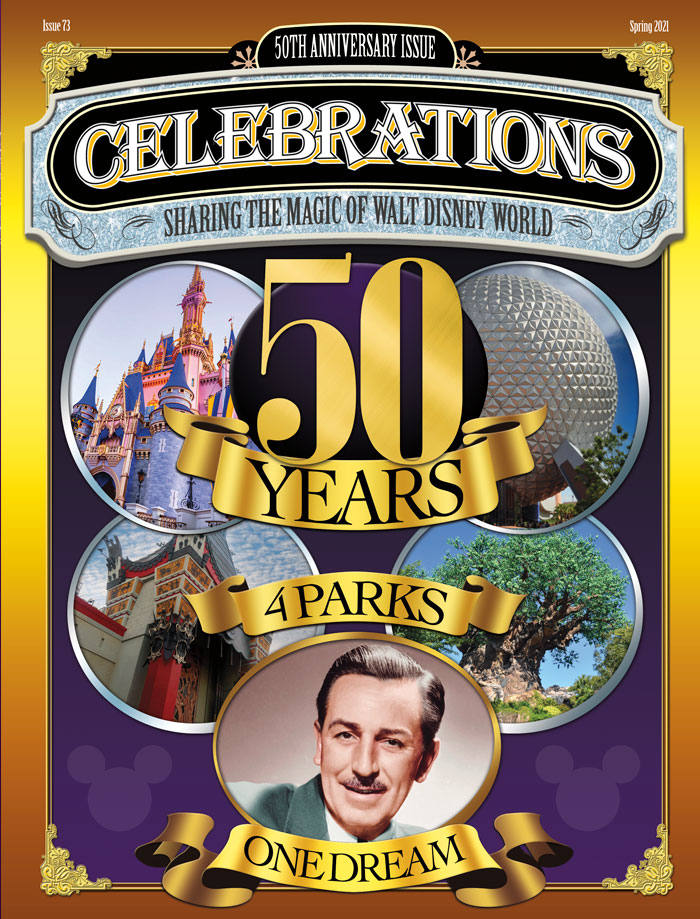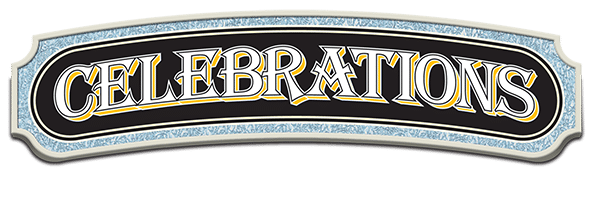The History of the EPCOT Logos

One of the unique aspects of EPCOT is the series of logos representing each of the original pavilions in Future World (Spaceship Earth, CommuniCore, Universe of Energy, Horizons, World of Motion, the Living Seas, the Land, and Journey Into Imagination). While the other Disney parks have their distinctive logos, EPCOT is unique in that it features a unified set of closely related symbols that reinforce the idea of the park being a modern-day world’s fair.
Creating the Icons
The logos were the creation of Norm Inouye, who was hired in 1979. This was Inouye’s first assignment, and he drew up hundreds of variations in a wide range of styles. “I did a whole series of different directions just to get a sense for where they were at,” Inouye said. “So when I learned they wanted a more contemporary design, we boiled things down. And consequently, that’s what we ended up with — something contemporary.”
Eventually, the design team (led by Imagineers John Hench and Marty Sklar) refined the logo designs, finally settling on the logos we’re familiar with today. (The one exception is the logo for the Wonders of Life pavilion, which was added later).
The challenge was to create a series of logos that would work together (including the logo for EPCOT itself) while clearly communicating the premise of each pavilion:

The first logo that Norm worked on was for the World of Motion. Nobody there, including John Hench or Marty Sklar, had any idea how to approach the logos, so many concepts were tried out. Walls were covered with hundreds of drawings, including variations of wagon wheels and lightning bolts. They eventually concluded that the logos should tell a story yet also be a symbol. With that idea in mind, Inouye came up with this graphical representation of motion.

The logo for Journey Into Imagination proved to be far more problematic and has actually turned out to be one of the most misinterpreted symbols in Walt Disney World. Many people think that it’s a camera shutter lens – which makes sense when considering that the original sponsor of the pavilion was Kodak. Norm recalled this being the most difficult of the logos to create (and, in his opinion, the least successful). The logo was intended to symbolize a vortex, one that would spin you into your imagination. In retrospect, Inouye said he would have designed it with more sense of perspective.

The logos for the Land and the Living Seas were the most straightforward, incorporating graphical representations of plants and waves, respectively.

Horizons was more abstract, but Inouye recalls that it was still one of the easier logos to execute. A sense of perspective was used to convey the idea of moving toward the horizon.

The Energy logo symbolized the sun, which seemed the natural choice due to the solar panels that were part of the pavilion (at that time – and still today – a very forward-thinking futuristic concept).

The CommuniCore logo might just be the cleverest of the bunch, combining two components. One was a simplified illustration of the actual buildings (two identical halves on either side of Future World,) and the other was a representation of two “C” s back to back (standing for “CommuniCore”).

Regarding EPCOT’s iconic attraction, Inouye reflected, “[Spaceship earth] was actually one of the last ones. Because Spaceship Earth was such an iconic building, there was some thought that maybe it didn’t need a logo. We finally decided that since they [the other pavilions] had one, it needed one too.”
The EPCOT Logo
So that’s the story of the attraction icons, but what about the logo for the park itself? Originally, World Showcase and Future World were conceptualized as two different parks, and logos were developed for each. An early version of the World Showcase logo from 1974 included the then-current Walt Disney World logo (incorporating the iconic big “D” with a globe and Mickey ears) next to the words “World Showcase” using the same font and the same globe. In 1975, a logo for Future World was created that featured a stylized Spaceship Earth next to the words “Future World” in the World Bold typeface, with “EPCOT Center” and the Walt Disney World logo underneath.

Eventually, the two parks were merged into one…and not just figuratively! Throughout the summer of 1976, Disney realized they would have difficulty recruiting enough corporations and foreign governments to fund both projects. As the Imagineers tried to devise a way to scale down the proposals (given the limited number of resources at their disposal), an executive meeting was rapidly approaching, and a decision needed to be made. Marty Sklar and John Hench pushed the two models together in a flash of inspiration, and everyone liked it. And so, EPCOT Center was born, and it was time for a logo.
An early concept for the EPCOT Center logo drawn up in 1978 featured the words “EPCOT CENTER” in World Bold next to the familiar Disney “D” (which was being used in applications beyond the resort at the time) enclosing a globe with a reversed stick figure (similar to what would become the Wonders of Life symbol). It was a clever design, but CEO Card Walker discarded this concept.

Inouye continued working on logo concepts, and one of his next ideas was to bring together the three components of EPCOT as he saw them: Disney, Business, and Nations. This led to a design that incorporated three overlapping circles. Even though this concept wasn’t used in the final design, it did plant the seed for what would eventually become EPCOT’s logo.

Inouye eventually came up with the five-ring logo that would become the final version, though his explanation of what the five rings symbolized was a bit complicated. In his mind, the five rings represented Information, Communication, Technology, Education, and Entertainment, key concepts that would come together to form EPCOT. Marty Sklar thought that this explanation was too technical, and he came up with this interpretation: “The EPCOT CENTER logo symbolizes unity, fellowship, and harmony around the world. Five outer rings are linked to form the shape of a flower – a celebration of life. The heart of the logo is the Earth, embraced by a star symbolizing hope – the hope that with imagination, commitment, and dedication, we can create a better tomorrow.”

In 1996 (the year that the naming convention of Epcot ’94 and Epcot ’95, each with their own logo, was abandoned), Disney unveiled a new logo for the park. The new design logo took the globe and transformed it into the “O” in Epcot, surrounded by a swoosh created by the letter “C.” Rather than the futuristic sans-serif typeface of the original logo, the font was switched to a classic serif face, with each letter given its own color.


The Epcot Logos Today
Disney had also moved away from the concept of individual pavilion icons in the 1990s. While a new icon was created for the Wonders of Life Pavilion, similar icons weren’t designed for new attractions like Mission: SPACE, Test Track, or Soarin’.
You could still find the original logos here and there, and they were sometimes included in new attractions as a tribute to the rides they had replaced. For example, you can find the Horizons logo in the space station in the queue of Mission: SPACE, and the World of Motion logo can be found on the fences and trash cans outside Test Track. But while many of the other logos were gone, they weren’t forgotten.
As part of EPCOT’s ongoing transformation, the tradition of pavilion icons was brought back. Logos were created for the park’s new attractions, as well as for the existing attractions that never received one. Twelve flags were added to the entrance courtyard in front of Spaceship Earth (six on each side, shown below), representing the complete set of EPCOT icons, past, present, and future. The original five-circle logo was also brought back, along with a slightly updated version of the World Bold EPCOT logo, just in time for the park’s grand 40th anniversary celebration.


The history of EPCOT’s logos is fascinating, and the reintroduction of these iconic designs is the perfect way to tie the history of this innovative park with its great, big, beautiful tomorrow. Even though we have a lot to look forward to in the months and years ahead, it’s comforting to see the logos of old back in the parks. It’s like having an old friend by our side!
Enjoy the magic of Disney all year ’round with Celebrations Magazine!

